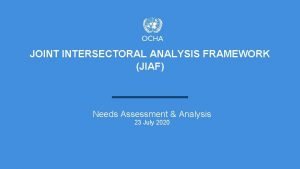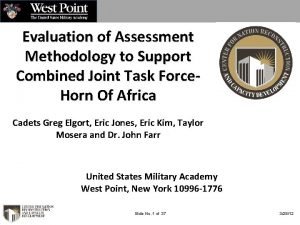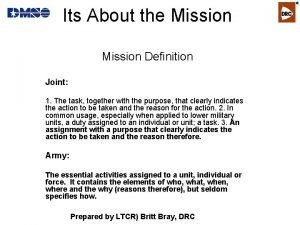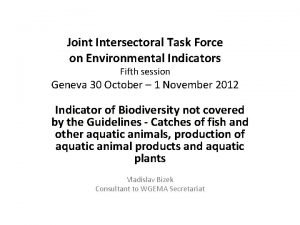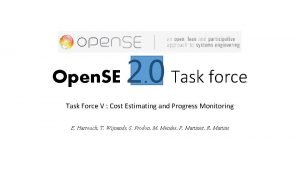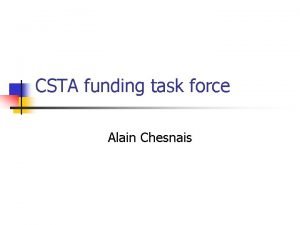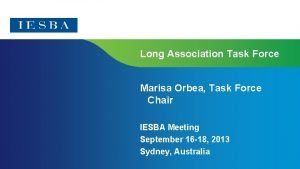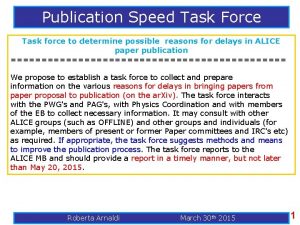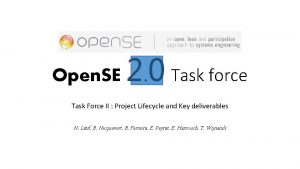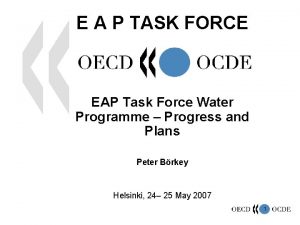Joint Intersectoral Task Force on Environmental Indicators Fifth












- Slides: 12

Joint Intersectoral Task Force on Environmental Indicators Fifth session Geneva, 4 – 6 July 2012 Grenhouse Gas Emissions Introductory Overview Vladislav Bizek Consultant to the Secretariat

Structure of Presentation Greenhouse gases (GHG) Origin of GHG LULUCF (Land use, land use change, forestry) Presentation of GHG emissions GHG emission inventory International legislation, supporting bodies and financial mechanisms • Reporting format • • •

Greenhouse gases Direct GHGs • • Carbon dioxide Methane Nitrous oxide F-gases • • • HFCs (hydrofluorocarbons) PFCs (perfluorocarbons) Sulphur hexafluoride (SF 6) Indirect GHGs • • Carbon monoxide Nitrogen oxides Sulphur dioxide NMVOC Other pollutants with the impact on climate • • Ground-level ozone Aerosols

Origin of GHGs Carbon dioxide • • Combustion of fossil fuels in stationary and mobile sources Certain technologies (e. g. cement production) Methane • • • Agriculture (animal breeding, rice growing) Mining and transport of fossil fuels Waste and waste water sector Nitrous oxide • • Agriculture (fertilizers) Certain technologies (chemical industry, catalytic convertors in vehicles) F-gases (HFCs, PFCs, SF 6) • Artificial products

LULUCF (Land use, land use change, forestry) • Important parameter of GHG balance • Covers emissions and removals of greenhouse gases resulting from direct human-induced land use, land-use change and forestry activities • It is mandatory for Annex 1 Parties to account for changes in carbons stocks resulting from deforestation, reforestation and afforestation and voluntary to account for emissions from forest management, cropland management, grazing land management and revegetation • LULUCF is expressed in CO 2

Presentation of GHG emissions - 1 Absolute values of emissions • Total national emissions • Emissions at lower territorial levels (region, municipality) • Emissions per economic sector Related values of emissions • Emissions per capita • Emissions per unit of land • Emissions per unit of GDP

Presentation of GHG emissions – 2 Aggregation Particular GHGs have different impact on climate, expressed in terms of „global warming potential (GWP)“ • • CO 2 has GWP = 1 Methane has GWP = cca 21 N 2 O has GWP = cca 310 F-gases have high values of GWP depending on particular chemical species Aggregated GHG emissions are calculated according to the formula: Total emission = S emission of particular GHG x respective GWP and expressed in tons of CO 2 equivalents

Presentation of emissions – 3 GHG Inventory in the Czech Republic (CO 2 eq. ) Greenhouse gas 2006 2007 2008 2009 CO 2 121. 7 125. 1 115. 5 106. 4 Of which emissions 125. 4 126. 1 120. 4 113. 4 Of which removals in LULUCF - 3. 6 - 0. 9 - 4. 9 - 7. 0 Methane 12. 2 11. 8 11. 7 11. 2 Nitrous oxide 7. 6 7. 7 7. 8 7. 3 F-gases 1. 0 1. 7 1. 3 1. 1 142. 6 146. 3 136. 4 126. 1 1. 2 1. 1 Total with LULUCF International air transport

GHG Emission Inventory Aggregation of particular GHG emission data • Calculation: Activity data x emission factor • Qualified estimate (fugitive emissions) International methodology 2006 IPCC Guidelines for National Greenhouse Gas Inventories at: http: //www. ipcc-nggip. iges. or. jp/public/2006 gl/index. html Updated UNFCCC reporting guidelines on annual inventories following incorporation of the provisions of decision 14/CP. 11 at English version: http: //unfccc. int/resource/docs/2006/sbsta/eng/09. pdf Russian version: http: //unfccc. int/resource/docs/2006/sbsta/rus/09 r. pdf

International legislation, supporting body and financial mechanisms 1992 UN Framework Convention on Climate Change • 1997 Kyoto Protocol Supporting body • Intergovernmental Panel on Climate Change (IPPC) Financial Mechanisms • EU ETS (EU Emission Trading Scheme) • JI (Joint Implementation) • CDM (Clean Development Mechanism)

Reporting format Common Reporting Format (CRF): Developed under IPPC Main categories of sources of GHG emissions • • Category 1: Energy • Of which combustion in stationary sources • Of which combustion in mobile sources • Of which fugitive emissions Category 2: Industrial processes Category 3: Solvent and other product use Category 4: Agriculture Category 5: Land use and forestry Category 6: Waste Category 7: Other and natural emissions Methodology: Updated UNFCCC reporting guidelines on annual inventories following incorporation of the provisions of decision 14/CP. 11 at English version: http: //unfccc. int/resource/docs/2006/sbsta/eng/09. pdf Russian version: http: //unfccc. int/resource/docs/2006/sbsta/rus/09 r. pdf

Thanks for your attention Contact: vladislav. bizek@gmail. com
 Joint intersectoral analysis framework
Joint intersectoral analysis framework Elements of phc
Elements of phc Combined joint task force horn of africa
Combined joint task force horn of africa Environmental indicators of physical child abuse
Environmental indicators of physical child abuse Tiered task bias task
Tiered task bias task Wireless health
Wireless health Universal joint task list
Universal joint task list Lamb grading chart
Lamb grading chart Cartilage between vertebrae
Cartilage between vertebrae Joint
Joint Joint venture account is a
Joint venture account is a Lamb grading chart
Lamb grading chart Condyloid ellipsoidal joint
Condyloid ellipsoidal joint
